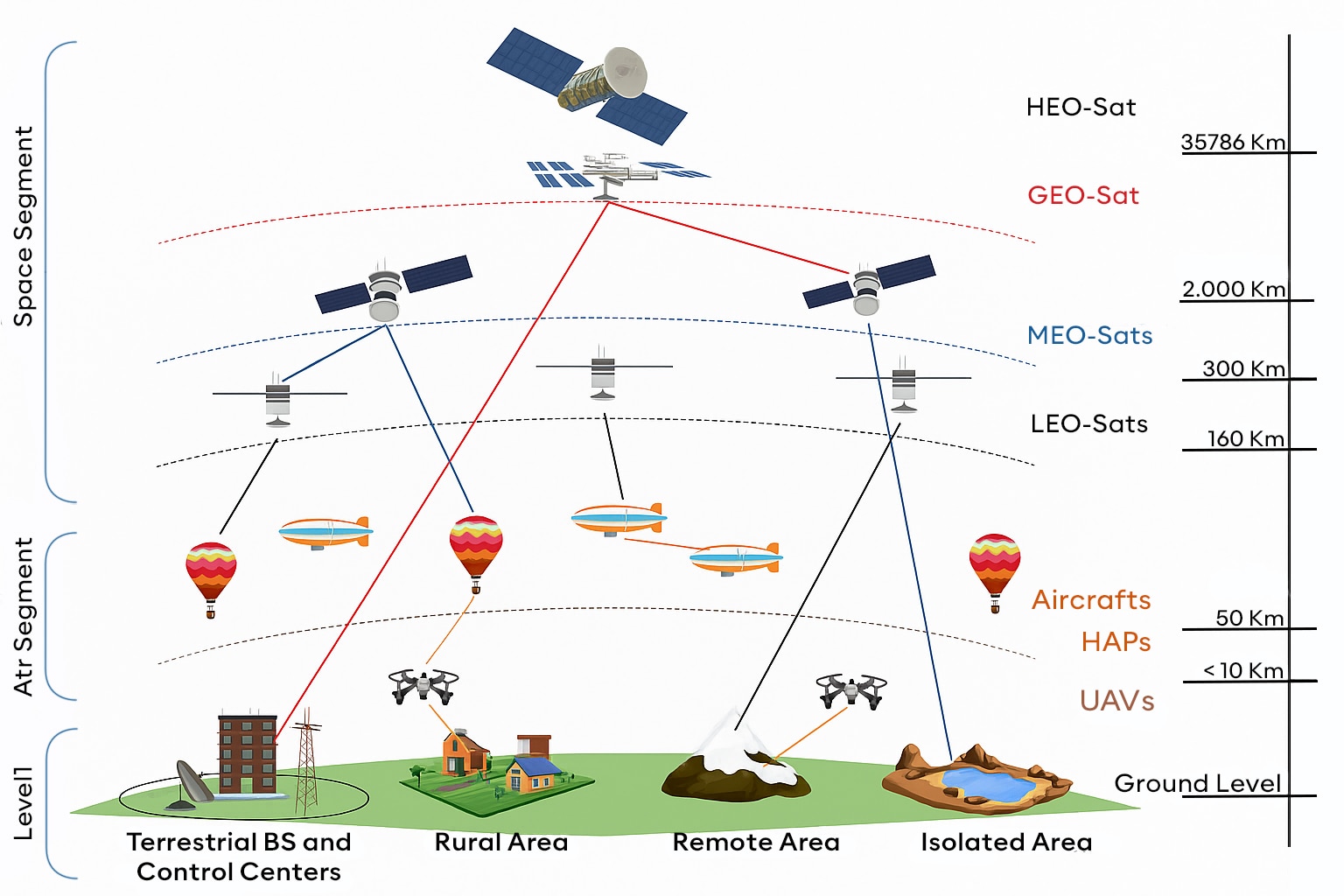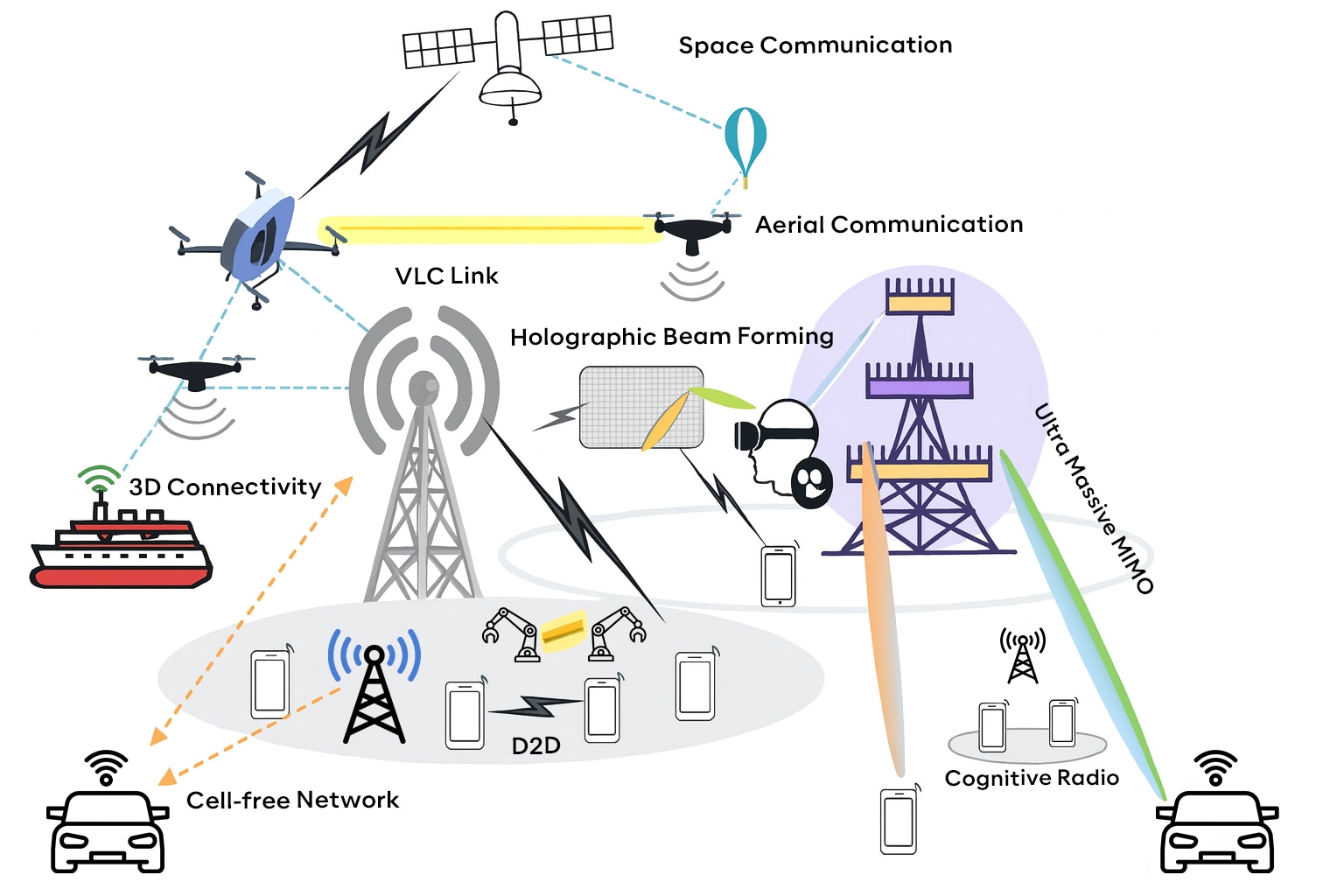)
Ubiquitous connectivity: connecting everything, everywhere.
Discovering how ubiquitous connectivity, through 3D communications and advanced network scalability, will transform industries like healthcare, smart cities, and entertainment, ensuring seamless communication across diverse environments and devices.
What is ubiquitous connectivity?
The sixth generation of mobile wireless networks introduces numerous innovative use cases. One of the most significant is related to the concept of Ubiquitous connectivity, which permits to enhance the networks and bridge the digital divide, by extending the connection to remote rural areas previously isolated. The term “Ubiquitous” means “present everywhere” and refers to a pervasive and consistent connectivity achieved through the integration with other access systems such as satellite networks, terrestrial communication systems, and emerging technologies like Internet of Things (IoT) and edge computing.

The role of ubiquitous networks
Providing continuous network access in even the most inaccessible and remote regions permits to overcome the environmental constraints and actualise the concept of Internet of Everything (IoE), where a reliable network is provided for anyone, at any time and on any device, ensuring a seamless connectivity across different environments and devices, without interruption.
Ubiquitous networks, enhanced by advanced technologies like 6G, fiber optics and satellite communications, are specifically designed to support high data rates, making them well-suited for applications that require significant bandwidth and rapid data transmission, such as Augmented reality (AR)/Virtual reality (VR) applications. These innovative networks also reduce latency ensuring seamless real-time interactions for time-sensitive applications. To achieve these high performances, 6G networks are expected to employ higher frequency bands, including millimeter waves (mmWave) and terahertz (THz) frequencies.
To handle the increasing number of connected devices and the rising demand of data, Ubiquitous connectivity must be highly scalable, enabling the network to dynamically allocate resources and optimise performance. By integrating artificial intelligence (AI) and machine learning (ML), these networks can autonomously manage and optimise resources. AI and ML algorithms predict network traffic patterns, allocate resources efficiently and adapt to changing conditions.
This connectivity aims to enhance overall quality of Experience (QoE) by ensuring consistent performance and seamless coverage addressing the limitations of previous generation networks.
3D integrated communications and the key enablers
Ubiquitous Network Connectivity with 3D Integrated Communications represents a paradigm shift where there will be interaction between technology and the world around, leveraging a suite of cutting-edge technologies to revolutionise the landscape of connectivity. Unlike traditional 2D networks which mainly focus on ground coverage, 3D communications extend connectivity to the airspace and underwater environments, by incorporating the vertical dimension.
The key enablers that make this scenario possible are the following:
Artificial Intelligence plays a crucial role, enabling intelligent decision-making, resource allocation across networks and channel estimation, enhancing the efficiency and adaptability of communication systems. Communication systems have become larger and more complex from generation to generation and many tasks would benefit from introducing native AI into them.
Internet of Things enables real-time data collection and sharing in a 3D space. IoT sensors integrated into various environments (urban, industrial, residential) are essential for monitoring and managing data from different dimensions and perspectives.
6G and beyond is the crucial technology which has potential to accelerate the realization of 3D integrated communications. To better support this scenario, the 6G signal should be integrated with other cutting-edge technologies that would make the process faster, safer, and more effective. The key technology is ISAC (Integrated Sensing and Communication), which combines radar sensing and wireless communication into a single system, optimising both data transmission and environmental awareness. Additionally, the RIS (Reconfigurable Intelligent Surfaces) is a software-controlled meta surface, composed of semi-passive elements which can be modified to shape the radio waves according to specific needs, in a position to enhance signal propagation by enabling dynamic reconfiguration of communication environments. Full duplex operation breaks conventional barriers by allowing simultaneous transmission and reception on the same frequency, effectively doubling capacity and reducing latency. RAN Slicing offers the ability to customise network resources for specific use cases, ensuring that different demands are met with precision and to make this happen in the best possible way, again AI plays a crucial role. Lastly, RAN infrastructure sharing encourages collaboration among operators, driving cost efficiency and promoting sustainable growth.
This integration of advanced technologies is set to redefine connectivity, making it more comprehensive, efficient and adaptable to the needs of the future.
Practical applications
The number of user terminals capable of connecting with each other will see a significant increase, whether on the same level (such as terrestrial-to-terrestrial) or across different levels (like terrestrial-to-aerial, terrestrial-to-underwater, or aerial-to-underwater) through various radio access networks.
Therefore, it will become commonplace for users to be connected to multiple cells simultaneously, with resources being dynamically shared among these cells through coordinated efforts. This shift will lead to the decline of the traditional cell-based structure, paving the way for a cell-less architecture that provides limitless connectivity through multiple RANs, ensuring a seamless and all-encompassing communication experience. Hence, synergy between the networks at the different levels will be crucial, with the goal of creating a single network capable of meeting all the necessary requirements for the implementation of use cases such as ultra-smart cities, remote surgeries and telemedicine, tactile internet or multi-D reality.

How can Reply support this innovation?
Reply assists customers in developing new use cases for ubiquitous connectivity by leveraging its extensive expertise in telecommunications and commitment to advancing the latest technologies. Our teams focus on integrating emerging technologies to enable a wide range of connected scenarios across various industries. To establish a competitive edge in the evolving 3D communications market, Reply draws on its existing capabilities and ongoing research and development to test and refine innovative solutions, ensuring the delivery of advanced connectivity offerings tailored to client needs.
Nova Reply

Nova Reply is a Reply Group company whose mission is to guide clients through digital transformation by enabling next-generation networks that deliver pervasive, distributed connectivity. The company focuses on the Aerospace and Defense markets, offering an end-to-end portfolio that spans the design and management of ubiquitous networks: from developing “Ubiquitous Networks” across terrestrial, space/satellite, and subsea domains, to creating platforms and solutions for end-to-end orchestration based on Network-as-a-Service models, through to defining use cases and designing, developing, and automating vertical applications.
)